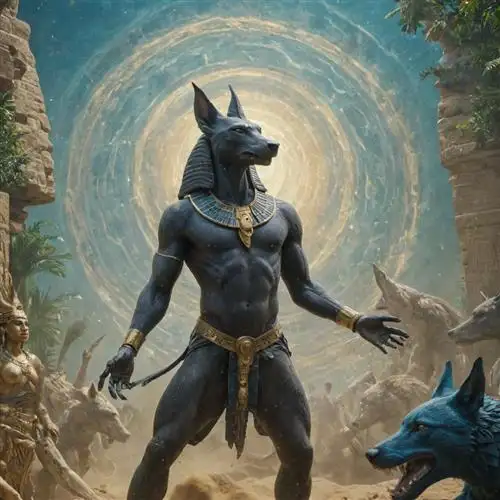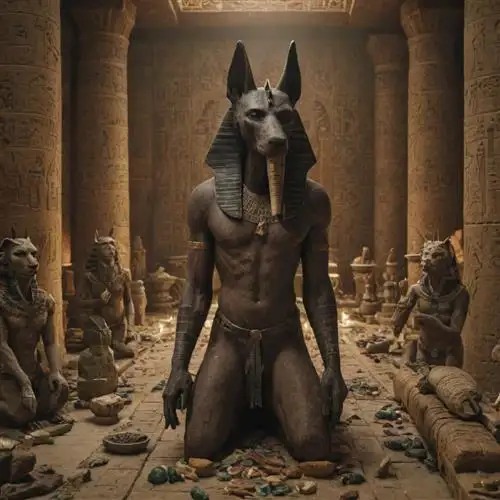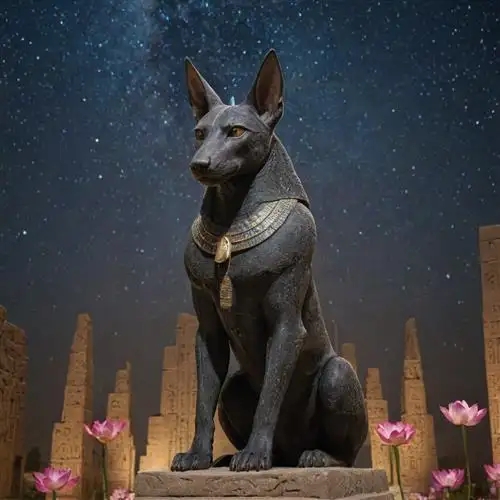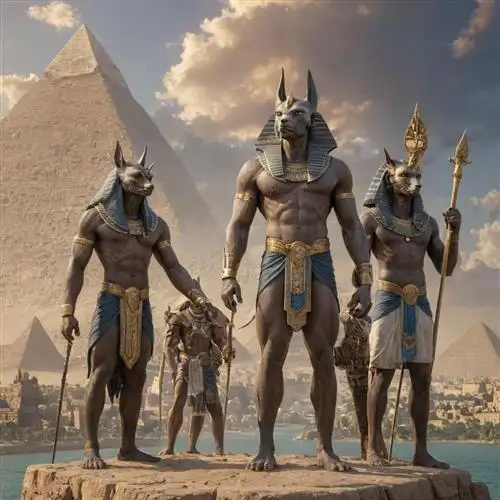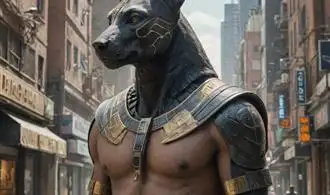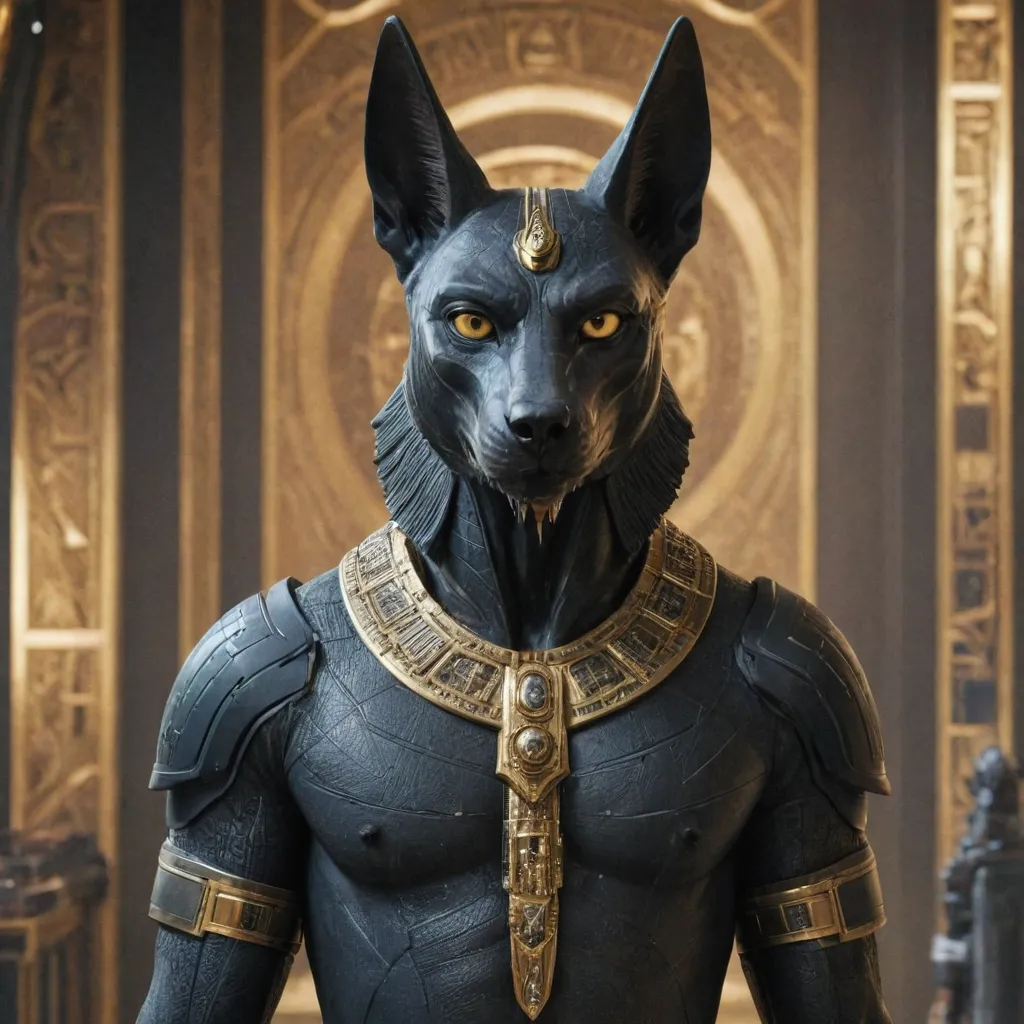
The Origins and Significance of Anubis
The Anubis deity occupies a central role in ancient Egyptian mythology, embodying a rich tapestry of symbolic meaning and mystical significance. Tracing the origins of this enigmatic figure reveals a profound connection to the fundamental principles of death, transition, and the guardianship of the afterlife.
Anubis, often depicted as a jackal-headed deity, was believed to be the son of the gods Osiris and Nephthys. This divine lineage imbued Anubis with the authority to preside over the embalming process, guiding the deceased on their journey to the afterlife. As the gatekeeper of the underworld, Anubis played a crucial role in the elaborate funerary rituals of ancient Egypt, ensuring the safe passage of the soul from the physical realm to the realm of the eternal.
The symbolism associated with Anubis is deeply rooted in the ancient Egyptians' reverence for the natural world. The jackal, an animal renowned for its scavenging abilities, was seen as a harbinger of the transition between life and death. Anubis' canine features represented the belief that the deity could traverse the liminal spaces between the living and the dead, serving as a intermediary between the mortal and the divine.
Beyond his role as the overseer of mummification and the afterlife, Anubis was also believed to be a guardian of tombs and a protector of the dead. The Fearless Exploration of the Iconography Surrounding Anubis reveals the intricate symbolism embedded in the deity's visual representations, which often included the distinctive black coloration of the jackal and the distinctive ankh, the symbol of life.
The significance of Anubis extended beyond the realm of the deceased, as the deity was also invoked in matters of justice and judgement. Anubis was believed to weigh the heart of the deceased against the feather of Ma'at, the goddess of truth and justice, to determine the worthiness of the soul for the afterlife. This pivotal role in the process of judgement solidified Anubis' status as a central figure in the ancient Egyptian pantheon, a guardian of the eternal balance between life and death.
Anubis Role in the Afterlife and Mummification
Anubis, the jackal-headed deity, held a significant role in ancient Egyptian mythology, particularly in the realm of the afterlife and the process of mummification. As the god of embalming and the protector of the dead, Anubis played a crucial part in guiding the deceased through the intricate journey of the afterlife.
One of Anubis's primary responsibilities was overseeing the mummification process. The ancient Egyptians believed that preserving the physical body was essential for the soul's successful transition to the afterlife. Anubis was responsible for the careful preparation of the deceased, ensuring the body was properly cleansed, embalmed, and wrapped in the intricate layers of linen that would protect and preserve it.
In the afterlife, Anubis held a central role in the weighing of the heart ceremony, a pivotal ritual that determined the deceased's fate. During this ceremony, the heart of the deceased was weighed against the feather of truth, representing the measure of the individual's moral and ethical conduct during their lifetime. Anubis was the guardian of this sacred ritual, ensuring the accuracy and fairness of the judgment.
Furthermore, Anubis was believed to guide the deceased through the dangerous and treacherous path of the underworld, protecting them from the various perils and obstacles that lay ahead. The ancient Egyptians would often place small statues of Anubis in the tombs, ensuring the god's constant presence and vigilance over the deceased.
Interestingly, Anubis was also associated with the process of mummification itself, as the jackal-headed deity was believed to have taught the art of embalming to the first embalmers. This connection further solidified Anubis's role as the patron of the dead and the guardian of the mummification rituals.
In addition to his duties in the afterlife, Anubis was also believed to have a protective function over the living. The ancient Egyptians often invoked Anubis's aid in times of danger or crisis, seeking the god's intervention and guidance to ensure their safety and well-being.
The Symbolic Representations of Anubis
The Symbolic Representations of Anubis, the enigmatic Egyptian deity, are a fascinating exploration into the rich tapestry of ancient Egyptian mythology. Anubis, the jackal-headed god, was revered for his role as the overseer of the afterlife, responsible for guiding the dead through the perilous journey to the next world.
One of the primary symbolic representations of Anubis is his jackal-like appearance, which served to connect him to the natural world and the cycles of life and death. Jackals were often found in the deserts, scavenging the remains of the deceased, and this association with the realm of the dead made Anubis a fitting guardian of the afterlife. The jackal head, with its distinctive pointed ears and sharp snout, was a visual representation of Anubis' primal connection to the wild and his role as a liminal figure, existing between the living and the dead.
Another significant symbolic representation of Anubis is his role as the embalmer and protector of the dead. In ancient Egyptian funerary practices, Anubis was responsible for the mummification process, ensuring the proper preservation of the deceased's physical body. This connection to the mummification rites and the preparation of the dead for the afterlife cemented Anubis' status as a crucial figure in the Egyptian pantheon. Controversies and Myths Surrounding Anubis Imagery Exposed explores the various interpretations and misconceptions surrounding the visual representations of this deity.
The scales of justice, another iconic symbol associated with Anubis, further emphasize his role as the judge of the dead. In the ritual of the Weighing of the Heart, Anubis would weigh the deceased's heart against the feather of Ma'at, the goddess of truth and justice. This process determined whether the individual was worthy of entering the afterlife, with Anubis ensuring the fairness and impartiality of this pivotal judgment.
The color black, which often characterized Anubis' iconography, held profound symbolic significance in ancient Egyptian culture. Black was associated with the fertile soil of the Nile River, as well as the color of the decomposing bodies that Anubis presided over. This connection to the cycle of life, death, and rebirth further cemented Anubis' role as a deity of the underworld and the guardian of the transition between the mortal and the divine realms.
Anubis Connections to Other Egyptian Deities
Anubis, the jackal-headed deity, holds a profound connection to other significant figures within the rich tapestry of ancient Egyptian mythology. As the god of the dead, Anubis maintained intricate relationships with various deities, each contributing to the complex and multifaceted nature of the Egyptian pantheon.
One of the most notable connections is Anubis' association with Osiris, the lord of the underworld. Anubis played a crucial role in the legendary story of Osiris' death and resurrection, serving as the embalmer and guide of the deceased ruler's soul. This close relationship underscores Anubis' importance in the process of mummification and the afterlife, cementing his status as a pivotal figure in the Egyptian belief system.
Furthermore, Anubis shared a close bond with the goddess Isis, the sister-wife of Osiris. Isis, renowned for her powerful magic and devotion to her husband, often collaborated with Anubis in the embalming and resurrection rites performed for Osiris. This partnership highlights the complementary roles of these deities in the realm of the dead and the preservation of the soul.
Additionally, Anubis maintained a strong connection to the sun god Ra, whose daily journey through the underworld was overseen by the jackal-headed deity. Anubis played a crucial role in guiding the souls of the deceased through the treacherous and mystical paths of the afterlife, ensuring their safe passage to the realm of the gods.
Interestingly, Anubis also shared some symbolic and conceptual overlaps with other Egyptian deities, such as Wepwawet, the "opener of the ways," who was also depicted with canine or jackal-like features. This interplay between various deities reflects the fluid and interconnected nature of the Egyptian divine pantheon, where the roles and attributes of different gods often intersected and complemented one another.
The Enduring Legacy of Anubis in Modern Culture
Anubis, the ancient Egyptian deity associated with mummification and the afterlife, has maintained a profound impact on modern culture. Far beyond his historical significance, the figure of Anubis continues to captivate and inspire artists, writers, and enthusiasts worldwide. From its representation in popular media to its enduring symbolism, the legacy of this enigmatic deity remains a testament to the enduring allure of ancient Egyptian mythology.
In the realm of art and literature, Anubis has been a frequent subject of fascination. Many contemporary artists have incorporated the iconic jackal-headed figure into their works, reinterpreting the deity's symbolism through a modern lens. Sculptors have crafted striking representations of Anubis, blending traditional Egyptian aesthetic with innovative techniques. Similarly, writers have explored the rich mythology surrounding Anubis, weaving the deity's narratives into their stories and exploring the profound mysteries of the afterlife that the god presides over.
The influence of Anubis extends beyond the artistic sphere, permeating popular culture as well. The god's distinct appearance and association with death and the underworld have made him a recurring motif in film, television, and video games. From blockbuster movies that feature Anubis as a central character to TV shows that incorporate the deity's symbolism, the figure of Anubis has become a recognizable icon in contemporary media. This widespread recognition speaks to the enduring fascination with ancient Egyptian mythology and the continued relevance of Anubis in our modern world.
Moreover, the enduring legacy of Anubis can be seen in the realm of spirituality and esotericism. The deity's connection to the afterlife and his role as the guardian of the dead have made him a significant figure in various spiritual and occult traditions. Practitioners of ancient Egyptian-inspired practices, as well as those drawn to the mysteries of the underworld, often incorporate Anubis into their rituals and meditations, seeking to tap into the deity's power and wisdom.

